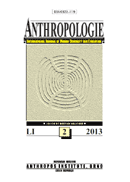|
|
| |
|
|
| |
Full text of article
'Juhász E, Sittová I, Falbová D, Sulis S, Holotová S, Vorobeľová L, 2025: ASSOCIATION OF SELECTED EXOGENOUS
FACTORS WITH BONE MINERAL DENSITY
IN A YOUNG ADULT POPULATION. Anthropologie (Brno) 63, 1: 15-22'. |
| |
| Abstract | | Bone mineral density (BMD) is a parameter that characterizes the strength and resistance of bone tissue to
fractures. It is influenced by many endogenous and exogenous factors, including lifestyle. Our work focused on determining
the prevalence of decreased BMD in the Slovak population aged 18–31 years (22.40 ± 0.12) and analyzing the correlations
between selected lifestyle factors and bone density parameters. The cohort consisted of 256 women (mean age 22.18 ±
0.16) and 153 men (mean age 22.76 ± 0.20). Statistical analysis of the data showed a relatively high number of participants
in the group with low BMD values (82.42% of women with Z-score values in the norm and 17.58% with low values, men
73.20% in the norm and 26.80% with low values). An association was found between vitamin D use in bone (p = 0.023;
r = 0.113). We confirmed the association between vitamin D intake and SOS, T and Z scores in women (p [SOS] = 0.026;
p [T] = 0.022; p [Z] = 0.034). Higher values were found in participants who took vitamin D supplements. An increase in
bone mineral content was observed with increasing frequency of milk and dairy product consumption (p = 0.050; r =
0.098). Our study shows that taking vitamin D and consuming milk and dairy products is a good way to maximize the
increase in bone mass during the BMD formation phase and slow down the decrease in bone density. | | | | Keywords | | Bone mineral density – Milk intake – Vitamin D – Calcium | | | | DOI | | https://doi.org/10.26720/anthro.25.02.12.1 | | |
|
|
|

 Full text (Password protected)
Full text (Password protected) Export citation
Export citation Related articles
Related articles